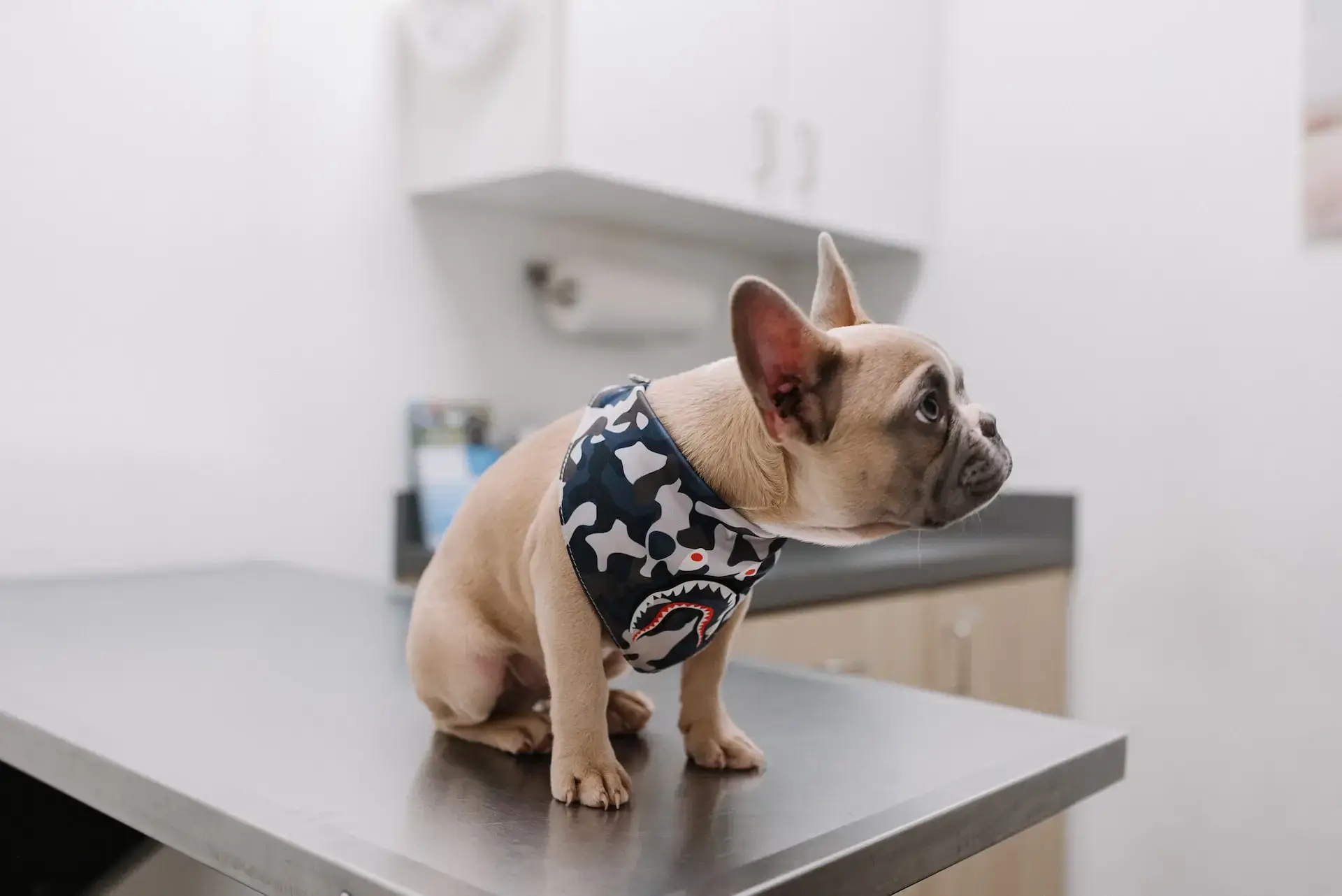Did you know that approximately one in five of our canine companions may experience allergies? Interestingly, this rate mirrors that of human allergies, with an estimated one in four individuals affected. In the U.S. alone, this accounts for about 100 million people. A Roanoke, VA veterinarian delves into the subject of dog allergies in this article.
Which Allergy Is Most Common in Dogs?
Skin complications often rank as the most prevalent issue among our loyal canine friends. These issues commonly stem from infestations by parasites like fleas. Furthermore, dogs may experience contact dermatitis, an allergic reaction triggered by direct contact with irritants. Food allergies are also not uncommon among our furry pals.
What Signs Do Dogs Show When They Have Allergies?
It can be challenging to detect your furry friend’s allergies. The symptoms can vary greatly from one dog to another. It all comes down to what triggers the reaction in Fido and how severe it is.
Take note of these cues:
- Runny Eyes
- Skin Problems: Redness, Flaking, Inflammation
- Licking Paws
- Coughing
- Diarrhea
- Itchiness
- Hair Loss
- Dander
- Swelling
- Vomiting
- Sneezing
- Hives
- Licking
- Face Rubbing
- Stubborn Ear Infections
- Itchy Ears
- Food Allergies
These indications might suggest a range of health issues, not only allergies. That’s why it’s essential to seek professional advice from your Roanoke, VA vet for Fido’s proper diagnosis.
What Leads to Allergies in Dogs?
Dog allergies function much like human allergies. Over time, Fido’s immune system develops an intolerance to a specific substance, typically a form of protein. This may include insect, plant, animal, or food protein.
After your pup’s immune system becomes reactive to a substance, it triggers an immune response, manufacturing antibodies. This sets off a sequence of events, prompting the discharge of histamines. These histamines initiate the reactions responsible for your pup’s distress, such as itching and swelling.
The immune system becomes overly enthusiastic in protecting against foreign agents.
Think of it like this: when it comes to allergens and immune system responses, things can get pretty tangled up. If you want the full scoop, chat with your vet.
What Kinds of Allergies Could Dogs Develop?
Dogs, similar to humans, manifest allergies that can be segmented into several groups and categorized in various manners. Categorizing canine allergies in this manner aids veterinarians in effectively diagnosing and addressing the root causes of a dog’s symptoms. Pinpointing the precise allergens responsible for triggering reactions enables pet owners to implement measures to reduce exposure and ease discomfort. These measures may include adjusting the dog’s diet, making environmental changes, and administering appropriate allergy medications.
Allergies Triggered by the Environment
Environmental allergies, as suggested by their name, arise from exposure to environmental elements. The list of possible triggers is vast, spanning from pollen, dust, and mold to grass, leaves, cigarette smoke, and perfume.
Allergies Triggered by Different Seasons
Seasonal allergies, essentially a subtype of environmental allergies, typically intensify during specific periods annually. This compilation encompasses a plethora of tree pollen, plants, grasses, leaves, and flowers. Remember, your furry companion can pick up pollen while joyfully bounding around the yard.
Allergies Triggered by Food
Among dogs, food allergies are notably common, encompassing a wide range of potential triggers. Whether it’s a reaction to the food as a whole or a specific ingredient like an additive or preservative, Fido’s response varies. Some dogs may display sensitivity to particular meats such as beef, chicken, or pork, while others react to corn or grains. Moreover, legumes and root vegetables can also provoke adverse reactions in Man’s Best Friend.
Allergies Triggered by Insects
Fido’s fur doesn’t provide complete protection against insect bites; he can have reactions to various bugs like fleas, blackflies, deer flies, horseflies, mosquitoes, ants, wasps, bees, and hornets. Additionally, dogs might react to arachnids such as spiders and ticks.
Allergies Triggered by Contact
Contact allergies can stem from a variety of substances, such as specific fabrics like those in your carpet or sofa, ingredients found in Fido’s dog shampoo, floor waxes, and mulch. Fido may also have allergies to dander or even your cat.
Anaphylaxis
Characterized as the most hazardous allergy type, it holds the potential for fatal outcomes. Essentially, it manifests as an extreme reaction, potentially stemming from bee stings, severe food allergies, or vaccine responses. While these circumstances are rare, these reactions pose significant risks and possibly death.
What Measures Should I Take to Care for a Dog Suffering from Allergies?
Begin by getting Fido to the vet for a precise diagnosis, as we mentioned earlier. That’s key to setting your furry friend up for the right care plan.
A few simple tasks around the house may help reduce allergy responses for Fido. To maintain a comfortable environment for your furry friend, it’s essential to reduce allergens at home. Regular vacuuming and dusting help eliminate dust, fur, dander, and pollen from carpets and furniture. Changing air filters regularly is also beneficial for improving indoor air quality. Furthermore, washing your pet’s bedding frequently with hot water and unscented detergent, following label instructions, and tumble drying are essential steps to keep allergens under control.
When decorating your home, it’s vital to consider allergies. When selecting a new sofa, choose one with an allergy-friendly covering such as leather. Add some softness with washable throw covers. Additionally, opt for window treatments that won’t trap dust to maintain a cleaner environment.
Another approach is to monitor pollen counts regularly. When they rise, limit your pet’s time outdoors. Also, consider wiping your dog’s paws and belly before letting them inside to reduce allergen exposure.
Finally, keeping up with Fido’s grooming and parasite control is essential to reduce any chances of an allergic reaction. For more details or if you have further questions, consult your vet.
What Actions to Take for My Dog’s Food Allergies?
Dealing with food allergies in pets can be complex, requiring precise identification of triggers. Your vet might recommend transitioning Fido to a bland diet temporarily to alleviate symptoms. After symptoms subside, the plan is often to reintroduce foods gradually to determine the specific allergen.
What Treatments Are Available for Allergies?
While allergies can’t be cured, there are ways to help your furry pal feel better. Start by setting up a vet appointment to find out what’s triggering your pup’s reaction. Then, you and your vet can talk about treatment options that work for your pet.
Treatment options vary and may involve medication. These may consist of anti-inflammatory drugs like corticosteroids or antihistamines, fatty acid supplements, or topical medication. Desensitization might also be beneficial for Fido, while a simple switch of shampoos could suffice in some cases. Additionally, if your furry friend has food allergies, your vet might suggest a specialized diet.
When Does Allergy Onset Occur in Dogs?
Fido’s susceptibility to allergies extends across his lifespan, with reactions possible at any age. Nevertheless, it’s unusual for dogs to develop allergies before the age of six months. Typically, allergic symptoms appear when the pup is at least one to two years old. This delay is due to Fido’s immune system requiring time to identify and respond unfavorably to specific substances.
Think your pooch might be battling allergies? Drop us a message at Southern Hills Animal Hospital in Roanoke, VA. We’re here to lend a paw!





